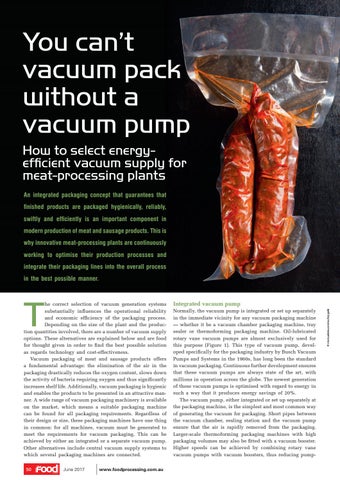You can’t vacuum pack without a vacuum pump How to select energyefficient vacuum supply for meat-processing plants An integrated packaging concept that guarantees that finished products are packaged hygienically, reliably, swiftly and efficiently is an important component in modern production of meat and sausage products. This is why innovative meat-processing plants are continuously working to optimise their production processes and integrate their packaging lines into the overall process in the best possible manner.
50
June 2017
www.foodprocessing.com.au
Integrated vacuum pump Normally, the vacuum pump is integrated or set up separately in the immediate vicinity for any vacuum packaging machine — whether it be a vacuum chamber packaging machine, tray sealer or thermoforming packaging machine. Oil-lubricated rotary vane vacuum pumps are almost exclusively used for this purpose (Figure 1). This type of vacuum pump, developed specifically for the packaging industry by Busch Vacuum Pumps and Systems in the 1960s, has long been the standard in vacuum packaging. Continuous further development ensures that these vacuum pumps are always state of the art, with millions in operation across the globe. The newest generation of these vacuum pumps is optimised with regard to energy in such a way that it produces energy savings of 20%. The vacuum pump, either integrated or set up separately at the packaging machine, is the simplest and most common way of generating the vacuum for packaging. Short pipes between the vacuum chamber, sealing station and the vacuum pump ensure that the air is rapidly removed from the packaging. Larger-scale thermoforming packaging machines with high packaging volumes may also be fitted with a vacuum booster. Higher speeds can be achieved by combining rotary vane vacuum pumps with vacuum boosters, thus reducing pump-
Š stock.adobe.com/au/Grygorii
T
he correct selection of vacuum generation systems substantially influences the operational reliability and economic efficiency of the packaging process. Depending on the size of the plant and the production quantities involved, there are a number of vacuum supply options. These alternatives are explained below and are food for thought given in order to find the best possible solution as regards technology and cost-effectiveness. Vacuum packaging of meat and sausage products offers a fundamental advantage: the elimination of the air in the packaging drastically reduces the oxygen content, slows down the activity of bacteria requiring oxygen and thus significantly increases shelf life. Additionally, vacuum packaging is hygienic and enables the products to be presented in an attractive manner. A wide range of vacuum packaging machinery is available on the market, which means a suitable packaging machine can be found for all packaging requirements. Regardless of their design or size, these packaging machines have one thing in common: for all machines, vacuum must be generated to meet the requirements for vacuum packaging. This can be achieved by either an integrated or a separate vacuum pump. Other alternatives include central vacuum supply systems to which several packaging machines are connected.
